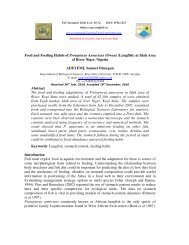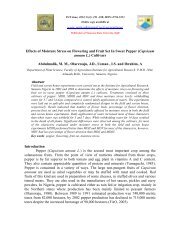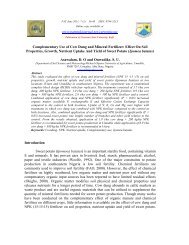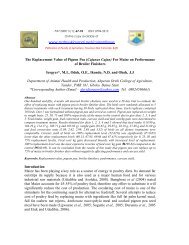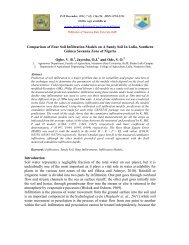Production and Utilization of Cassava in Nigeria: Prospects for Food ...
Production and Utilization of Cassava in Nigeria: Prospects for Food ...
Production and Utilization of Cassava in Nigeria: Prospects for Food ...
You also want an ePaper? Increase the reach of your titles
YUMPU automatically turns print PDFs into web optimized ePapers that Google loves.
PAT 2008; 4 (1): 38-52: ISSN: 0794-5213Onl<strong>in</strong>e copy available atwww.patnsukjournal.com/currentissue<strong>Production</strong> <strong>and</strong> <strong>Utilization</strong> <strong>of</strong> <strong>Cassava</strong> <strong>in</strong> <strong>Nigeria</strong>: <strong>Prospects</strong> <strong>for</strong> <strong>Food</strong> Security<strong>and</strong> Infant NutritionEchebiri, R. N <strong>and</strong> Edaba M.E. IDepartment <strong>of</strong> Agricultural EconomicsMichael Okpara University <strong>of</strong> Agriculture, Umudike, Abia State.e-mail: enraphael@yahoo.comAbstract<strong>Cassava</strong> is the chief source <strong>of</strong> dietary food energy <strong>for</strong> the majority <strong>of</strong> the people liv<strong>in</strong>g <strong>in</strong> the lowl<strong>and</strong>tropics, <strong>and</strong> much <strong>of</strong> the sub-humid tropics <strong>of</strong> West <strong>and</strong> Central Africa. There<strong>for</strong>e, its production <strong>and</strong>utilization must be given prime attention <strong>in</strong> food policy. The adoption <strong>of</strong> high yield<strong>in</strong>g varieties <strong>and</strong>the result<strong>in</strong>g <strong>in</strong>crease <strong>in</strong> yield have shifted the problem <strong>of</strong> the cassava sector from supply to dem<strong>and</strong>issues, such as f<strong>in</strong>d<strong>in</strong>g new uses <strong>and</strong> markets <strong>for</strong> cassava. In this paper, analysis is done based onempirical results <strong>of</strong> surveys on various aspects <strong>of</strong> cassava production, dem<strong>and</strong> <strong>and</strong> utilization. Datawere sourced from survey reports published by FAO, USDA, FOS, IITA, CBN <strong>and</strong> the World Bank.The analysis revealed that because <strong>of</strong> its high carbohydrate content <strong>and</strong> low expenditure elasticities,cassava provides greater proportion <strong>of</strong> energy <strong>for</strong> low-<strong>in</strong>come households than any other food item.It was further shown that cassava is used <strong>in</strong> the preparation <strong>of</strong> several household foods <strong>and</strong>derivatives, such as paste, biscuits, bread sagos <strong>and</strong> sauce. <strong>Cassava</strong> starch is also <strong>in</strong>dustriallymodified to provide products with physical <strong>and</strong> chemical properties <strong>for</strong> specific applications,<strong>in</strong>clud<strong>in</strong>g the preparation <strong>of</strong> baby food, jelly, thicken<strong>in</strong>g agents, gravies, custard powders, glucose,<strong>and</strong> confectioneries. To make cassava more relevant <strong>for</strong> maternal <strong>and</strong> <strong>in</strong>fant feed<strong>in</strong>g, it isrecommended among other th<strong>in</strong>gs, to <strong>in</strong>troduce some <strong>in</strong>novations which may be necessary to<strong>in</strong>crease acceptability <strong>and</strong> nutritional content <strong>of</strong> locally prepared cassava-based baby foods, <strong>in</strong> our<strong>in</strong>digenous <strong>in</strong>dustries.Keywords: <strong>Cassava</strong>, <strong>Production</strong>, <strong>Utilization</strong>, <strong>Food</strong> security, Infant feed<strong>in</strong>g.IntroductionToday, the amount <strong>of</strong> food available per person on a global basis is 18 percenthigher than 30 years ago. Most develop<strong>in</strong>g countries benefited from thisdevelopment with the result that their nutrition has witnessed very tremendousimprovement. As impressive as this improvement is, about 800 million peopleworldwide still suffer from chronic hunger; <strong>and</strong> one quarter <strong>of</strong> this populationresides <strong>in</strong> Africa. The situation gets worse every year <strong>and</strong> can lead to a catastrophe ifit is not possible to <strong>in</strong>crease food supply at a rate faster than that at which the worldpopulation <strong>in</strong>creases (Knirsch, 1996a).<strong>Cassava</strong> is the chief source <strong>of</strong> dietary food energy <strong>for</strong> the majority <strong>of</strong> the peopleliv<strong>in</strong>g <strong>in</strong> the lowl<strong>and</strong> tropics, <strong>and</strong> much <strong>of</strong> the sub-humid tropics <strong>of</strong> West <strong>and</strong>Central Africa (Tsegia et al, 2002). There<strong>for</strong>e, its production <strong>and</strong> utilization must be
PAT 2008; 4 (1): 38-52: ISSN: 0794-5213; Echebiri, R. N <strong>and</strong> Edaba M.E. I: <strong>Production</strong> <strong>and</strong> <strong>Utilization</strong> <strong>of</strong> <strong>Cassava</strong> … 39given prime attention <strong>in</strong> food policy. Even though farmers have not yet atta<strong>in</strong>ed thedesired technical efficiency <strong>in</strong> cassava production as a result <strong>of</strong> weak access toexternal <strong>in</strong>puts such as fertilizers <strong>and</strong> herbicides (Ezed<strong>in</strong>ma et al, 2006), the widescaleadoption <strong>of</strong> high yield<strong>in</strong>g varieties <strong>and</strong> the result<strong>in</strong>g <strong>in</strong>crease <strong>in</strong> yield haveshifted the problem <strong>of</strong> the cassava sector from supply (production) to dem<strong>and</strong> issues,such as f<strong>in</strong>d<strong>in</strong>g new uses <strong>and</strong> markets <strong>for</strong> cassava. The government <strong>of</strong> <strong>Nigeria</strong>considers a transition from the present status <strong>of</strong> usage to the level <strong>of</strong> <strong>in</strong>dustrial rawmaterial <strong>and</strong> livestock feed as a development goal that can spur growth with <strong>in</strong>crease<strong>in</strong> employment. This consideration underscores the various research <strong>and</strong> policy<strong>in</strong>itiatives <strong>in</strong> cassava improvement, production, <strong>and</strong> process<strong>in</strong>g.Estimates <strong>of</strong> <strong>in</strong>dustrial cassava use <strong>in</strong> <strong>Nigeria</strong> suggest that approximately 16 percent<strong>of</strong> cassava root production was utilized as chips <strong>in</strong> animal feed, 5 percent wasprocessed <strong>in</strong>to a syrup concentrate <strong>for</strong> s<strong>of</strong>t dr<strong>in</strong>ks <strong>and</strong> less than 1 percent wasprocessed <strong>in</strong>to high quality cassava flour used <strong>in</strong> biscuits <strong>and</strong> confectionery, dextr<strong>in</strong>,adhesives, starch, <strong>and</strong> hydrolysates <strong>for</strong> pharmaceuticals <strong>and</strong> season<strong>in</strong>gs (Ene, 1992).At present, a wide range <strong>of</strong> traditional cassava <strong>for</strong>ms (such as gari, fufu, starch,lafun, abacha, etc) are produced <strong>for</strong> human consumption (Kormawa et al, 2003). Inview <strong>of</strong> the renewed emphasis on cassava production (supply), process<strong>in</strong>g <strong>and</strong>utilization <strong>in</strong> <strong>Nigeria</strong>, it becomes necessary to assess the production, dem<strong>and</strong> <strong>and</strong>utilization patterns <strong>of</strong> cassava, <strong>and</strong> its prospects especially <strong>in</strong> combat<strong>in</strong>g hunger <strong>and</strong>rais<strong>in</strong>g food security among vulnerable groups <strong>in</strong>clud<strong>in</strong>g women <strong>and</strong> <strong>in</strong>fants.Accord<strong>in</strong>gly, the objective <strong>of</strong> this paper is to exam<strong>in</strong>e <strong>and</strong> evaluate the supply <strong>and</strong>dem<strong>and</strong> trends <strong>of</strong> cassava <strong>and</strong> its potentials <strong>of</strong> ensur<strong>in</strong>g food security <strong>in</strong> <strong>Nigeria</strong>.<strong>Food</strong> Security: Def<strong>in</strong>ition <strong>and</strong> ApplicationThe def<strong>in</strong>ition <strong>of</strong> food security adopted <strong>in</strong> this work is based on the FAO (2000)recommendation <strong>of</strong> 2300 kcal per adult per day. In this concept, food security isdef<strong>in</strong>ed <strong>in</strong> terms <strong>of</strong> the household. A household is said to be food secure when all itsmembers have access to 2300 kcal <strong>of</strong> energy or more per day, all the year round, ormost times <strong>of</strong> the year, without fac<strong>in</strong>g the possibility <strong>of</strong> loos<strong>in</strong>g the access <strong>in</strong> thefuture. Modify<strong>in</strong>g the concepts <strong>of</strong> McDonald <strong>and</strong> M<strong>of</strong>fit (1980) <strong>and</strong> Omonona(2001), the food security status <strong>of</strong> households can be expressed notationally asfollows:Fsec n =0 <strong>for</strong> X n < Z (1)Fsec n =1 <strong>for</strong> X n ≥ Z (2)where,Fsec n = food security status <strong>of</strong> household nX n = per capita calorie consumption <strong>of</strong> household nZ = recommended daily m<strong>in</strong>imum energy requirement <strong>of</strong> 2300 Kcal
PAT 2008; 4 (1): 38-52: ISSN: 0794-5213; Echebiri, R. N <strong>and</strong> Edaba M.E. I: <strong>Production</strong> <strong>and</strong> <strong>Utilization</strong> <strong>of</strong> <strong>Cassava</strong> … 40Equations (1) <strong>and</strong> (2) express the status <strong>of</strong> a household as be<strong>in</strong>g food <strong>in</strong>secure orfood secure. In equation (1), food security is zero because households <strong>in</strong> thecategory have per capita calorie consumption (X n ) less than the recommendedm<strong>in</strong>imum <strong>of</strong> 2300kcal per adult per day. Households represented <strong>in</strong> equation (2) arethose that have per capita calorie <strong>in</strong>take <strong>of</strong> more than or equal to this recommendedm<strong>in</strong>imum requirement.The degree <strong>of</strong> deviation <strong>of</strong> a household from this m<strong>in</strong>imum requirement <strong>in</strong>dicatestheir level <strong>of</strong> food lack. This level <strong>of</strong> food deprivation is estimated with the shortfallor surplus <strong>in</strong>dex, which captures the severity <strong>of</strong> hunger <strong>and</strong> gives a rather tentative<strong>in</strong>dication <strong>of</strong> the extent <strong>of</strong> corrective measures needed to address food <strong>in</strong>securitysituation <strong>of</strong> a particular population. Furthermore, to determ<strong>in</strong>e the proportion <strong>of</strong> thepopulation that is below or above the food <strong>in</strong>security l<strong>in</strong>e, the headcount ratio isadopted.Materials <strong>and</strong> MethodsStudy area <strong>and</strong> scopeThe analysis done <strong>in</strong> this paper is based on data derived from surveys on variousaspects <strong>of</strong> cassava production, dem<strong>and</strong> <strong>and</strong> utilization <strong>in</strong> <strong>Nigeria</strong>.Data requirements <strong>and</strong> sourcesData required <strong>for</strong> the study were primarily <strong>of</strong> the secondary <strong>for</strong>m. In l<strong>in</strong>e with thebroad <strong>and</strong> specific objectives <strong>of</strong> the study, data needed <strong>in</strong>cluded levels <strong>of</strong> cassavaproduction, agronomic characteristics <strong>of</strong> cassava, types <strong>of</strong> cassava products, <strong>and</strong>dem<strong>and</strong> elasticities, cassava dem<strong>and</strong> estimates, consumption pattern, <strong>and</strong> utilizationprospects. These relevant data were sourced from journals, magaz<strong>in</strong>es, bullet<strong>in</strong>s,manuals, <strong>and</strong> other publications. In particular survey reports published by FAO,USDA, FOS, IITA, CBN <strong>and</strong> the World Bank were <strong>of</strong> much relevance.Analytical TechniqueThe study is qualitative <strong>in</strong> approach. Data from the sources listed above were closelyexam<strong>in</strong>ed, <strong>and</strong> deductive analysis was done follow<strong>in</strong>g established empiricalknowledge <strong>and</strong> theory.Results <strong>and</strong> Discussion<strong>Cassava</strong> production pr<strong>of</strong>ile <strong>in</strong> <strong>Nigeria</strong><strong>Nigeria</strong> grows more cassava than any other country <strong>in</strong> the world. The production <strong>of</strong>cassava is concentrated <strong>in</strong> the h<strong>and</strong>s <strong>of</strong> numerous smallholder farmers locatedprimarily <strong>in</strong> the south <strong>and</strong> central regions <strong>of</strong> <strong>Nigeria</strong>. A significant population <strong>of</strong>cassava growers <strong>in</strong> <strong>Nigeria</strong> has made the transition from traditional productionsystems to the use <strong>of</strong> high-yield<strong>in</strong>g varieties <strong>and</strong> mechanization <strong>of</strong> process<strong>in</strong>g
PAT 2008; 4 (1): 38-52: ISSN: 0794-5213; Echebiri, R. N <strong>and</strong> Edaba M.E. I: <strong>Production</strong> <strong>and</strong> <strong>Utilization</strong> <strong>of</strong> <strong>Cassava</strong> … 41activities (Nweke et al, 2002). Accord<strong>in</strong>g to Berry (1993), <strong>Nigeria</strong> <strong>and</strong> Zaire possessboth large <strong>and</strong> small scale farms on which cassava is grown by full-time <strong>and</strong> parttimefarmers. In these farm<strong>in</strong>g areas, an average <strong>of</strong> about 45 percent <strong>of</strong> cassava fieldwere cultivated <strong>for</strong> commercial purposes, but this varied from 0 to 100 percent(Nweke, 1989).Table 1: Levels <strong>of</strong> <strong>Cassava</strong> <strong>Production</strong> from 1990-2003 (tons)Year <strong>Nigeria</strong> Cameroon Togo1990 19,043,008 1,587,872 592,8671991 26,004,000 1,622,000 510,5281992 29,184,000 1,636,000 452,0931993 30,128,000 1,648,000 389,4481994 31,005,000 1,715,000 531,5261995 31,404,000 1,780,000 607,2221996 32,050,000 1,848,000 548,3161997 32,695,000 1,918,000 595,7921998 32,698,000 1,965,950 579,3811999 32,070,000 1,889,191 693,9982000 32,810,000 191,830 7,000,6992001 32,586,000 1,947,266 651,5302002 34,476,000 2,200,000 729,7082003 33,379,000 2,619,142 724,000Source: FAO (2004)FAO (2004) provides statistics <strong>of</strong> cassava production <strong>in</strong> three countries, <strong>Nigeria</strong>,Cameroun <strong>and</strong> Togo, <strong>for</strong> the period 1990 to 2003 (Table 1, Figures 1, 2 <strong>and</strong> 3). Thedata show that cassava production witnessed <strong>in</strong>creases <strong>in</strong> the three countries with<strong>Nigeria</strong> be<strong>in</strong>g clearly <strong>in</strong> the lead. As shown <strong>in</strong> figure 1, these data were subjected tographical analysis to further demonstrate production trend <strong>in</strong> the three countries. Theslope <strong>of</strong> the graph <strong>in</strong>dicates that <strong>Nigeria</strong> records an annual production <strong>in</strong>crease <strong>of</strong>about 1.3 million tons, while Togo recorded an <strong>in</strong>crease <strong>of</strong> about 31,000 tons perannum <strong>for</strong> the same period. <strong>Nigeria</strong>’s immense potential <strong>for</strong> cassava production isfurther shown by the high positive <strong>in</strong>tercept, which suggests high productivitylevels.
Figure 1: Annual <strong>Cassava</strong> production trendPAT 2008; 4 (1): 38-52: ISSN: 0794-5213; Echebiri, R. N <strong>and</strong> Edaba M.E. I: <strong>Production</strong> <strong>and</strong> <strong>Utilization</strong> <strong>of</strong> <strong>Cassava</strong> … 4240,000,00035,000,000y = 1E+06x + 2E+07R 2 = 0.420230,000,000<strong>Production</strong> (tons)25,000,00020,000,00015,000,00010,000,0005,000,0000y = 30487x + 2E+06R 2 = 0.05881990 1991 1992 1993 1994 1995 1996 1997 1998 1999 2000 2001 2002 2003Period (years)<strong>Nigeria</strong> Cameroon Togo L<strong>in</strong>ear (<strong>Nigeria</strong>) L<strong>in</strong>ear (Cameroon)Figure 1: <strong>Cassava</strong> <strong>Production</strong> Trend <strong>for</strong> <strong>Nigeria</strong>, Cameroun <strong>and</strong> Togo (1990-2003)Figure 2: <strong>Cassava</strong> Prodcution Trend <strong>for</strong> the period 1990 to 1999Figure 3: <strong>Cassava</strong> <strong>Production</strong> trend <strong>for</strong> the period <strong>of</strong> 2000 to 2003300,000,000140,000,000250,000,000120,000,000production level (tons)200,000,000150,000,000100,000,000<strong>Production</strong> level (tons)100,000,00080,000,00060,000,00040,000,00050,000,00020,000,00001period (1990 -1999)0Period (2000 - 2003)<strong>Nigeria</strong> Cameroun Togo<strong>Nigeria</strong> Cameroon TogoFigure 2: <strong>Cassava</strong> <strong>Production</strong> Trend <strong>for</strong> <strong>Nigeria</strong>, Cameroun<strong>and</strong> Togo, 1990-1999.Figure 3: <strong>Cassava</strong> <strong>Production</strong> Trend <strong>for</strong> <strong>Nigeria</strong>, Cameroun<strong>and</strong> Togo, 2000-2003.Several factors were believed to have facilitated the rapid spread <strong>of</strong> cassavacultivation <strong>in</strong> <strong>Nigeria</strong>. First, the agronomic <strong>and</strong> nutritional advantages <strong>of</strong> cassavaover other staples, <strong>and</strong> second, the vastly superior storage potential <strong>of</strong> cassavaproducts. Other desirable qualities that aided the high distribution <strong>of</strong> cassava <strong>in</strong><strong>Nigeria</strong> <strong>in</strong>clude its adaptability to relatively marg<strong>in</strong>al soil <strong>and</strong> erratic ra<strong>in</strong>-fedconditions. Also, there is the certa<strong>in</strong>ty <strong>of</strong> obta<strong>in</strong><strong>in</strong>g some yields even under the mostadverse conditions <strong>and</strong> its flexibility with respect to time <strong>of</strong> plant<strong>in</strong>g <strong>and</strong> harvest<strong>in</strong>g.
PAT 2008; 4 (1): 38-52: ISSN: 0794-5213; Echebiri, R. N <strong>and</strong> Edaba M.E. I: <strong>Production</strong> <strong>and</strong> <strong>Utilization</strong> <strong>of</strong> <strong>Cassava</strong> … 43Agboola (1968) gave an outl<strong>in</strong>e <strong>of</strong> the agronomic characteristics <strong>of</strong> cassava, asummary <strong>of</strong> which was given by Wheatley et al (1995) as shown <strong>in</strong> Table 2 below.Table 2: Agronomic characteristics <strong>of</strong> cassavaCharacteristicPeriodGrowth period (month) 9-24Optimal temperature ( 0 C) 25-29Optimal ra<strong>in</strong>fall (cm) 100-150Optimal pH 5-6Fertilizer requirement LowPlant<strong>in</strong>g materialStemSource: Wheatley et al (1995)Determ<strong>in</strong>ants <strong>of</strong> Supply <strong>and</strong> Dem<strong>and</strong> <strong>for</strong> <strong>Cassava</strong>For a given level <strong>of</strong> <strong>in</strong>come, the quantity <strong>of</strong> commodity consumed becomes afunction <strong>of</strong> its price (Bouse, 1994). Generally, the dem<strong>and</strong> <strong>for</strong> a commodity dependsnot only on its price <strong>and</strong> the consumer’s <strong>in</strong>come, but also on the price <strong>of</strong> all othercommodities (Adegeye et al, 1985). It is based on this assumption that a consumer’sobjective is to maximize his utility <strong>in</strong> the consumption <strong>of</strong> a commodity with<strong>in</strong> hisbudget constra<strong>in</strong>t.Let a constra<strong>in</strong>ed utility function be expressed as:U = Q 1 Q 2 + λ(Y 0 -P 1 Q 1 -P 2 Q 2 ) (3)Where U = Total utilityQ 1, Q 2 = Commodities consumedP 1, P 2 = Prices <strong>of</strong> commoditiesY 0 = Consumers <strong>in</strong>come that imposes sett<strong>in</strong>g a constra<strong>in</strong>t on totalexpenditure <strong>of</strong> Q 1 Q 2 . The partial derivatives <strong>of</strong> the above equate to zero, <strong>in</strong> l<strong>in</strong>e withfirst order condition <strong>for</strong> optimization. Thus we have:δu/δQ 1 = Q 2 - λP 1 = 0 (4)δu/δQ 2 = Q 1 - λP 2 = 0 (5)δu/δλ = Y 0 - P 1 Q 1 -P 2 Q 2 = 0 (6)Solv<strong>in</strong>g <strong>for</strong> the utility maximiz<strong>in</strong>g Q 1 <strong>and</strong> Q 2 (assum<strong>in</strong>g that the second ordersatisfaction is satisfied). We have:Q 1 = Y 0 /2P 1 , Q 2 = Y 0 /2P 2 (7)These expressions provide the basic def<strong>in</strong>ition <strong>of</strong> dem<strong>and</strong> function (Hengyum et al,2003).Reason<strong>in</strong>g <strong>in</strong> a similar manner, Kormawa (2002) <strong>and</strong> Kuo et al (2003) reported thathousehold <strong>in</strong>come, prices <strong>of</strong> commodities, preference <strong>and</strong> other socio-demographicvariables such as age, household size, education level etc affect calorie supply <strong>and</strong>
PAT 2008; 4 (1): 38-52: ISSN: 0794-5213; Echebiri, R. N <strong>and</strong> Edaba M.E. I: <strong>Production</strong> <strong>and</strong> <strong>Utilization</strong> <strong>of</strong> <strong>Cassava</strong> … 45Table 4: Animal Feed Rations us<strong>in</strong>g <strong>Cassava</strong> MealTypes <strong>of</strong> feed Percentage cassava mealCautius MaximumBroiler starter 5 10Broiler f<strong>in</strong>isher (4 wks) 10 20Chick starter 5 10Pullet starter 10 25Layer 25 40Piglets 5 10Pigs (8-18 wks) 10 25Source: Eagleston et al (1992)Furthermore, cassava starch, cassava flour, cassava juice <strong>and</strong> fermented cassava arenow used <strong>in</strong> <strong>in</strong>dustries (Terry et al, 1983; Ene, 1992; Olomu, 1995). For <strong>in</strong>stance,cassava starch is used <strong>in</strong> mak<strong>in</strong>g products such as biscuits, bread <strong>and</strong> derivativessuch as sagos <strong>and</strong> sauce. <strong>Cassava</strong> starch has also been <strong>in</strong>dustrially modified toprovide products with physical <strong>and</strong> chemical properties <strong>for</strong> specific applications,<strong>in</strong>clud<strong>in</strong>g the preparation <strong>of</strong> jelly, thicken<strong>in</strong>g agents, gravies, custard powders, babyfood, glucose <strong>and</strong> confectioneries (Ene, 1992).Apart from be<strong>in</strong>g used <strong>in</strong> variety <strong>of</strong> paste products such as spaghetti <strong>and</strong> macaroni,cassava flour has been identified to be useful <strong>in</strong> the manufacture <strong>of</strong> cassava beer <strong>in</strong>the brewery <strong>in</strong>dustry (Olomu, 1995). In addition, Terry et al (1983) noted that s<strong>in</strong>cethe rapid escalation <strong>of</strong> energy cost, especially liquid fuel prices, considerableattention has been given to cassava as a source <strong>of</strong> ethanol with particular example <strong>in</strong>Brazil, where enormous ef<strong>for</strong>t had been put <strong>in</strong>to production <strong>of</strong> alcohol us<strong>in</strong>gsugarcane <strong>and</strong> cassava as biological resources.Dem<strong>and</strong> Estimates <strong>of</strong> <strong>Cassava</strong> Supply <strong>in</strong> <strong>Nigeria</strong>The tolerance <strong>of</strong> cassava to extreme stress conditions, its low production resourcerequirements, its biological efficiency <strong>in</strong> the production <strong>of</strong> food energy, itsavailability throughout the year <strong>and</strong> its stability <strong>for</strong> farm<strong>in</strong>g systems, will makecassava products ga<strong>in</strong> more popularity <strong>in</strong> <strong>Nigeria</strong> (Kormawa et al, 2003). Sequel tothis consensus view, Eagleston et al (1992) submitted that cassava will have betteryield <strong>and</strong> quality improved varieties, cultural practices <strong>and</strong> process<strong>in</strong>g technology.As shown <strong>in</strong> Table 5 <strong>and</strong> figure 4, FAO (2004) made projections on the dem<strong>and</strong> <strong>for</strong>cassava <strong>in</strong> the <strong>for</strong>eseeable future.
PAT 2008; 4 (1): 38-52: ISSN: 0794-5213; Echebiri, R. N <strong>and</strong> Edaba M.E. I: <strong>Production</strong> <strong>and</strong> <strong>Utilization</strong> <strong>of</strong> <strong>Cassava</strong> … 46Table 5: <strong>Cassava</strong> Dem<strong>and</strong> Estimates by 2007 (tons)Product Export Import Total<strong>Food</strong> 5,700,000 1,825,000 7,525,000Starch 1,770,000 3,200,000 4,970,000Livestock feed 15,622,000 75,621,248 91,243,248Ethanol 900,000 2,700,000 3,600,000Total 23,992,000 83,346,248 107,338,248Source: FAO (2004)Projection <strong>of</strong> <strong>Cassava</strong> Export by 2007, <strong>Nigeria</strong>Projection <strong>of</strong> <strong>Cassava</strong> Import by 2007, <strong>Nigeria</strong>4%24%3%2% 4%65%Figure 4(a)7%<strong>Food</strong>StarchLivestockEthanol91%Figure 4(b)<strong>Food</strong>StarchLivestockEthanolFigure 4: Projection <strong>of</strong> <strong>Cassava</strong> dem<strong>and</strong> (a) export <strong>and</strong> (b) import, <strong>for</strong> <strong>Nigeria</strong> <strong>in</strong>2007.The estimates <strong>for</strong> the potential growth <strong>of</strong> <strong>Nigeria</strong>’s urban <strong>and</strong> rural dem<strong>and</strong> arebased on population growth projections <strong>and</strong> the ma<strong>in</strong>tenance <strong>of</strong> current average percapita consumption. Knipscheer (2003) gave conservative estimates <strong>of</strong> cassavafuture dem<strong>and</strong>s <strong>in</strong> <strong>Nigeria</strong> as presented <strong>in</strong> Table 6.Table 6: Conservative Estimates <strong>of</strong> <strong>Cassava</strong> Future Dem<strong>and</strong>s (tons) <strong>in</strong> <strong>Nigeria</strong>Sector Current alternative ProductuseSubstitution(%)Equivalent <strong>in</strong> fresh cassavaroot<strong>Food</strong> 1,180,000 20 1,000,000Starch 67,100 100 350,000Livestock 1,200,000 20 1,000,000Ethanol 20,900 100 2,000,000Total 2,468,000 4,350,000Source: Knipscheer, (2003)Besides the estimates <strong>in</strong> the previous tables, Kormawa (2003) presented what can bereferred to as “middle <strong>of</strong> the road” estimate <strong>of</strong> potential dem<strong>and</strong> <strong>for</strong> cassava (tons) <strong>in</strong><strong>Nigeria</strong>. These estimates are presented <strong>in</strong> Table 7, figure 5 below:
PAT 2008; 4 (1): 38-52: ISSN: 0794-5213; Echebiri, R. N <strong>and</strong> Edaba M.E. I: <strong>Production</strong> <strong>and</strong> <strong>Utilization</strong> <strong>of</strong> <strong>Cassava</strong> … 47Table 7: Estimate <strong>of</strong> Potential/Dem<strong>and</strong> <strong>for</strong> <strong>Cassava</strong> (tons) <strong>in</strong> <strong>Nigeria</strong>SectorPotential/ Market<strong>Food</strong> <strong>for</strong> urban market 14,157,438<strong>Food</strong> <strong>for</strong> rural market 4,378,788<strong>Food</strong> <strong>for</strong> export 1,825,000<strong>Food</strong> as flour 1,170,055Livestock 675,000Starch 335,000Ethanol 139,347Total 22,680,628Source: Kormawa (2003)Estimate <strong>of</strong> Potential/Dem<strong>and</strong> <strong>for</strong> <strong>Cassava</strong> (tons) <strong>in</strong><strong>Nigeria</strong>16,000,000Dem<strong>and</strong> potential14,000,00012,000,00010,000,0008,000,0006,000,0004,000,0002,000,00001SectorsSectorsFigure<strong>Food</strong> <strong>for</strong> urban market<strong>Food</strong> <strong>for</strong> rural market<strong>Food</strong> <strong>for</strong> export<strong>Food</strong> as flourLivestockStarchEthanolFigure 5: <strong>Cassava</strong> dem<strong>and</strong> estimate <strong>for</strong> <strong>Nigeria</strong>, accord<strong>in</strong>g sectorsTrends <strong>and</strong> <strong>Prospects</strong> <strong>of</strong> <strong>Cassava</strong> <strong>in</strong> <strong>Nigeria</strong>’s <strong>Food</strong> Security Needs<strong>Cassava</strong> has virtually turned to pure gold <strong>in</strong> <strong>Nigeria</strong>. Less than five years ago, thecountry was desperately look<strong>in</strong>g <strong>for</strong> export market <strong>for</strong> the farm produce as a result<strong>of</strong> glut <strong>in</strong> the local market. But the situation has changed due to the trade promotionpolicy <strong>of</strong> the federal government (Ojeagbase, 2005). Stress<strong>in</strong>g the <strong>in</strong>fluence <strong>of</strong> thepresidential <strong>in</strong>itiative on cassava <strong>in</strong> <strong>Nigeria</strong>, Anga (2005) observed that the tradepromotion policy <strong>of</strong> the federal government has created a very strong domesticdem<strong>and</strong> <strong>and</strong> market. So strong is the dem<strong>and</strong> that big-time cassava farmers now earnalmost as much money from the produce locally than they could make if theyexported the commodity. Ojeagbase (2005) reported that on the <strong>in</strong>ternational market,a ton <strong>of</strong> cassava was sell<strong>in</strong>g <strong>for</strong> US$120 (about N15,000). By contrast, the price wasUS$130 (N16,000) with<strong>in</strong> <strong>Nigeria</strong>. This gives a difference <strong>of</strong> $10 <strong>and</strong> without thestress <strong>of</strong> gett<strong>in</strong>g the product ready <strong>for</strong> export. All the processors <strong>of</strong> feeds are now
PAT 2008; 4 (1): 38-52: ISSN: 0794-5213; Echebiri, R. N <strong>and</strong> Edaba M.E. I: <strong>Production</strong> <strong>and</strong> <strong>Utilization</strong> <strong>of</strong> <strong>Cassava</strong> … 48f<strong>in</strong>d<strong>in</strong>g cassava an effective option <strong>for</strong> maize <strong>and</strong> there is a move to replace orpartially replace maize with cassava chips.USDA (2001) projected that develop<strong>in</strong>g countries will represent a larger share <strong>of</strong>orld food dem<strong>and</strong> <strong>and</strong> wil be the major <strong>for</strong>ce driv<strong>in</strong>g trade <strong>in</strong> calorie. Ris<strong>in</strong>g percapita <strong>in</strong>come <strong>in</strong> develop<strong>in</strong>g countries over the com<strong>in</strong>g decade will lead to a greaterdem<strong>and</strong> <strong>for</strong> high-value products. Aromolaram (2004) posited that shifts <strong>in</strong> foodconsumption patterns tend to vary across countries based on their level <strong>of</strong> economicdevelopment. He noted that at the highest <strong>in</strong>come levels, per capita consumption <strong>of</strong>both cereals <strong>and</strong> roots <strong>and</strong> tubers decreased between 1961 <strong>and</strong> 1981, whileconsumption <strong>of</strong> meat products <strong>in</strong>creased substantially. In low <strong>in</strong>come countrieswhere food security rema<strong>in</strong>s a concern despite recent economic ga<strong>in</strong>s, decreases <strong>in</strong>root <strong>and</strong> tuber availability were more than <strong>of</strong>fset by dramatic <strong>in</strong>creases <strong>in</strong> per capitasupply <strong>of</strong> all other food products.Differences <strong>in</strong> total food availability between developed <strong>and</strong> develop<strong>in</strong>g countriesare also reflected <strong>in</strong> their respective food budget shares. In low <strong>in</strong>come countries,food accounts <strong>for</strong> a greater portion (47 percent) <strong>of</strong> consumers total budget than <strong>in</strong>wealthier countries where, on average, food expenditures account <strong>for</strong> only 13percent (USDA, 2001). Staple food products such as cassava products, rice <strong>and</strong> yamaccount <strong>for</strong> larger shares <strong>of</strong> the total food budget <strong>in</strong> low <strong>in</strong>come countries.In <strong>Nigeria</strong>, cassava can be processed <strong>in</strong>to different <strong>for</strong>ms utilizable by man. IITA(2002) identified <strong>and</strong> highlighted the characteristics <strong>of</strong> the common <strong>for</strong>ms <strong>of</strong> cassavaproducts available <strong>in</strong> <strong>Nigeria</strong>. These <strong>in</strong>clude gari, fufu, cassava chips, cassava flour,starch, far<strong>in</strong>a, tapioca, macaroni, cassava bread <strong>and</strong> pudd<strong>in</strong>g. A survey conducted bythe Federal M<strong>in</strong>istry <strong>of</strong> Health the results <strong>of</strong> which are shown <strong>in</strong> Table 8 below<strong>in</strong>dicates that the frequency <strong>of</strong> consumption <strong>of</strong> cassava products is high <strong>in</strong> somestates <strong>of</strong> the country.Table 8: Frequency <strong>of</strong> <strong>Cassava</strong> Consumption <strong>in</strong> <strong>Nigeria</strong>State 1-2 times (%) 3-4 times (%) More than 4 times (%)Osun 29 36 33Akwa Ibom 29 39 33Bayelsa 21 15 51Edo 21 25 53Imo 24 21 43Kaduna 74 18 4Kano 57 37 4Kebbi 84 15 0Kwara 27 38 35Borno 65 28 4Taraba 37 25 33Zamfara 43 27 30Source: Federal M<strong>in</strong>istry <strong>of</strong> Health, <strong>Nigeria</strong> (2004)
PAT 2008; 4 (1): 38-52: ISSN: 0794-5213; Echebiri, R. N <strong>and</strong> Edaba M.E. I: <strong>Production</strong> <strong>and</strong> <strong>Utilization</strong> <strong>of</strong> <strong>Cassava</strong> … 49Table 9: Consumption Pattern <strong>of</strong> <strong>Cassava</strong> Products <strong>in</strong> <strong>Nigeria</strong>ZoneOrder <strong>of</strong> PreferenceSouth SouthGari, Akpu/FufuSouth WestGari, Lafun, Akpu/FufuSouth EastGari, Fufu, AkpuNorth CentralGari, Fufu, StarchNorth EastGari, Fufu, Akpu, AbachaSouce: Kormawa <strong>and</strong> Akoroda (2003)Furthermore, consumption pattern <strong>of</strong> cassava products by zone is given below <strong>in</strong>Table 9. The above tables suggest that cassava is fast chang<strong>in</strong>g from an <strong>in</strong>ferior foodto a necessity <strong>in</strong> <strong>Nigeria</strong>. Gari <strong>for</strong> <strong>in</strong>stance is becom<strong>in</strong>g the most popular <strong>for</strong>m <strong>in</strong>which cassava is consumed. Tsegai et al (2002) agrees that cassava is an excellentsource <strong>of</strong> dietary energy, <strong>and</strong> it smacks <strong>of</strong> short-sightedness to consider cassavasolely a subsistence food crop.Conclusion <strong>and</strong> Policy ImplicationsAs consensus cont<strong>in</strong>ues to grow with regard to the appropriate strategies <strong>for</strong>combat<strong>in</strong>g food <strong>in</strong>security <strong>in</strong> <strong>Nigeria</strong> <strong>and</strong> Sub-Saharan Africa <strong>in</strong> general, it becomesnecessary to evaluate trends <strong>of</strong> production <strong>and</strong> utilization <strong>of</strong> major staples. It is by sodo<strong>in</strong>g that the imbalances <strong>in</strong> domestic production <strong>and</strong> dem<strong>and</strong> are spotlighted <strong>and</strong>adequate remedies sought. <strong>Food</strong> supply <strong>and</strong> dem<strong>and</strong> have their <strong>in</strong>fluences on eachother. An adequate effective dem<strong>and</strong> <strong>for</strong> food is needed to susta<strong>in</strong> the growth <strong>in</strong> foodproduction because producers need market <strong>for</strong> their products. Because <strong>of</strong> the highcost <strong>of</strong> production <strong>of</strong> other crops, coupled with their high agro-climaticrequirements, they are more expensive compared to cassava <strong>and</strong> may not beaccessible to the urban poor at some periods <strong>of</strong> the year. Thus, with the grow<strong>in</strong>gpopulation <strong>in</strong> <strong>Nigeria</strong> <strong>and</strong> decl<strong>in</strong><strong>in</strong>g real <strong>in</strong>comes, cassava has the potential <strong>of</strong>combat<strong>in</strong>g human hunger among adults <strong>and</strong> <strong>in</strong>fants alike <strong>and</strong> hence will rema<strong>in</strong> apillar <strong>of</strong> food security <strong>for</strong> the citizenry.SuggestionsThe market potential <strong>of</strong> cassava depends on technological trans<strong>for</strong>mation. Thedevelopment <strong>of</strong> appropriate <strong>and</strong> cost-effective farm-level technologies is critical <strong>for</strong>exp<strong>and</strong><strong>in</strong>g the production <strong>and</strong> market <strong>for</strong> cassava now <strong>and</strong> <strong>in</strong> future. A dual policyapproach is there<strong>for</strong>e recommended <strong>in</strong> which the government <strong>of</strong> <strong>Nigeria</strong> shouldencourage backward <strong>in</strong>tegration <strong>for</strong> greater <strong>in</strong>dustrial utilization <strong>and</strong> at the sametime, support exist<strong>in</strong>g small-holder production systems through an effective <strong>in</strong>putdelivery system.Development <strong>of</strong> cost effective <strong>and</strong> nutritionally sound technologies <strong>for</strong> cassavaprocess<strong>in</strong>g <strong>and</strong> storage need not be over-emphasized. In order to effectivelyappropriate the food security potentials <strong>of</strong> cassava, it is important that chang<strong>in</strong>g
PAT 2008; 4 (1): 38-52: ISSN: 0794-5213; Echebiri, R. N <strong>and</strong> Edaba M.E. I: <strong>Production</strong> <strong>and</strong> <strong>Utilization</strong> <strong>of</strong> <strong>Cassava</strong> … 50tastes <strong>and</strong> preferences must <strong>for</strong>m the basis <strong>for</strong> explor<strong>in</strong>g new products <strong>and</strong>process<strong>in</strong>g techniques. In this connection, it is recommended that greater capacitymust be built <strong>for</strong> multi-discipl<strong>in</strong>ary research <strong>and</strong> development. Such research <strong>and</strong>development ef<strong>for</strong>ts will undoubtedly reveal a host <strong>of</strong> cassava based products <strong>and</strong>alternative process<strong>in</strong>g technologies that will diversify household nutrition base <strong>and</strong><strong>in</strong>fant feed<strong>in</strong>g.ReferencesAdegeye, A. <strong>and</strong> S. Ditto (1985). Essentials <strong>of</strong> Agricultural Economics. Ibadan.Impact Publishers <strong>Nigeria</strong> Ltd. Pp13-45.Agboola, S.A. (1968). Introduction <strong>and</strong> Spread <strong>of</strong> cassava <strong>in</strong> Western <strong>Nigeria</strong>. NigerEconomics <strong>and</strong> Social Studies 10(3) pp369-385.Anga, B. (2005). Dem<strong>and</strong> <strong>for</strong> <strong>Cassava</strong> <strong>Production</strong> Equipment up by 500 percent. InSuccess Digest. May 2005. p.9Aromolaram, A.B. (2004). Intra-household Redistribution <strong>of</strong> Income <strong>and</strong> CalorieConsumption <strong>in</strong> South-Western <strong>Nigeria</strong>. F<strong>in</strong>al Research Report, YaleUniversity, New Haven.Berry, S.S. (1993). Socio-economic Aspects <strong>of</strong> <strong>Cassava</strong> cultivation <strong>and</strong> Use <strong>in</strong>Africa: Implication <strong>for</strong> Development <strong>of</strong> Appropriate Technology.COSCA No. 8. Ibadan.Bouse, H.C. ((1994). The Effect <strong>of</strong> Income on Dem<strong>and</strong> <strong>for</strong> <strong>Food</strong> <strong>in</strong> Poor Countries:Are our <strong>Food</strong> Consumption Database giv<strong>in</strong>g us Reliable Estimates? Journal<strong>of</strong> Devlopment Economics 44 (1994). Pp.196CBN (Central Bank <strong>of</strong> <strong>Nigeria</strong>) (1992). National Consumer Survey. Central Bank <strong>of</strong><strong>Nigeria</strong>, Abuja.Eagleston, G. B., M.B. Okoye <strong>and</strong> V.M. Jeon (1992). Traditional African Methods<strong>of</strong> <strong>Cassava</strong> Process<strong>in</strong>g <strong>and</strong> Utilisation <strong>and</strong> Research Needs. In Tropical RootCrops <strong>Production</strong> <strong>of</strong> Roots Crops-Based Industries. Pp.4-6Ene, L.S.O. (1992). <strong>Prospects</strong> <strong>for</strong> Process<strong>in</strong>g <strong>and</strong> <strong>Utilization</strong> <strong>of</strong> Root <strong>and</strong> TuberCrops. In National Root Crops Promotion <strong>of</strong> Root Crop-Based Industries.Pp. 7-11.Ezed<strong>in</strong>ma, C., A.G.O. Dixon, L. Sanni, R. Okechukwu, M. Akoroda, J. Lemehi, F.Ogbe <strong>and</strong> E.Okoro (2006). Trends <strong>in</strong> <strong>Cassava</strong> <strong>Production</strong> <strong>and</strong>Commercialization <strong>in</strong> <strong>Nigeria</strong>. International Institute <strong>of</strong> TropicalAgriculture.Ezed<strong>in</strong>ma, C., N. Nkang <strong>and</strong> I. Simon (2006). Price Transmission <strong>and</strong> MarketIntegration: A test <strong>of</strong> the Central Market Hypothesis <strong>of</strong> GeographicalMarkets <strong>for</strong> <strong>Cassava</strong> Products <strong>in</strong> <strong>Nigeria</strong>. International Institute <strong>of</strong> TropicalAgriculture (IITA). Ibadan.FAO (<strong>Food</strong> <strong>and</strong> Agricultural Organisation) (2000). The State <strong>of</strong> <strong>Food</strong> Insecurity <strong>in</strong>The World. <strong>Food</strong> <strong>and</strong> Agricultural Organisation <strong>of</strong> the United Nations.
PAT 2008; 4 (1): 38-52: ISSN: 0794-5213; Echebiri, R. N <strong>and</strong> Edaba M.E. I: <strong>Production</strong> <strong>and</strong> <strong>Utilization</strong> <strong>of</strong> <strong>Cassava</strong> … 51FAO (<strong>Food</strong> <strong>and</strong> Agricultural Organization) <strong>of</strong> United Nations (2004). AnnualStatistics. Rome, Italy.Federal M<strong>in</strong>istry <strong>of</strong> Health (2004). Frequency <strong>of</strong> <strong>Cassava</strong> <strong>Production</strong> <strong>in</strong> <strong>Nigeria</strong>.Federal M<strong>in</strong>istry <strong>of</strong> Health, <strong>Nigeria</strong> (2004).FOS (Federal Office <strong>of</strong> Statistics) (1999). Annual Abstract <strong>of</strong> Statistics. FederalOffice <strong>of</strong> Statistics, Abuja.Fresho,I. O. (1993). The Dynamics <strong>of</strong> <strong>Cassava</strong> <strong>in</strong> Africa. An Outl<strong>in</strong>e <strong>of</strong> ResearchIssues.COSCA,No 9 Collaborative Study <strong>in</strong> Africa. Pp 13-15.Hengyum, M. Huang, J; <strong>and</strong> Rae, E. (2003 Livestock products consumption patterns<strong>in</strong> Urban <strong>and</strong> Rural Ch<strong>in</strong>a. In Ch<strong>in</strong>a, Agricultural work<strong>in</strong>g paper 1 (08) NewZeal<strong>and</strong> Centre <strong>for</strong> applied economics <strong>and</strong> policy studies, Massey University,New Zeal<strong>and</strong>.IITA (International Institute <strong>of</strong> Tropical Agriculture (IITA) (1990). <strong>Cassava</strong> <strong>in</strong>Tropical Agriculture: A Practical Manual. International Root Crop-BasedIndustries (1989). Pp.4-6IITA (International Institute <strong>of</strong> Tropical Agriculture (IITA) (2002). CompetitivenessWorkshop. In opportunities <strong>for</strong> <strong>Cassava</strong> <strong>in</strong> <strong>Nigeria</strong>: Bookanga, IITA,Ibadan.Knipscheer, H.C. (2003). Opportunities <strong>in</strong> the Industrial <strong>Cassava</strong> Market <strong>in</strong> <strong>Nigeria</strong>.IITA, Ibadan.Knirsch, J. (1996). Grow<strong>in</strong>g <strong>Food</strong> Security: Challeng<strong>in</strong>g the L<strong>in</strong>k betweenPesticides <strong>and</strong> Access to <strong>Food</strong>. PAN Publications, London. Pp.7-13.Knirsch, J. (1996). Pesticides <strong>and</strong> Global <strong>Food</strong> Security. PAN Publishers. Pp7-15.Kormawa, P. <strong>and</strong> M.O. Akoroda (2003). <strong>Cassava</strong> Supply Cha<strong>in</strong> Arrangement <strong>for</strong>Industrial <strong>Utilization</strong> <strong>in</strong> <strong>Nigeria</strong>. Ibadan.Kuo, S.H. <strong>and</strong> B. L<strong>in</strong> (2003). Estimation <strong>of</strong> <strong>Food</strong> Dem<strong>and</strong> <strong>and</strong> Nutrient Elasticitiesfrom Household Survey. In Economic Research Service. USDA (2003).Pp.1-8.McDonald, J.F. <strong>and</strong> R.A. M<strong>of</strong>fit (1980). The use <strong>of</strong> Tobit analysis. Review <strong>of</strong>Economics <strong>and</strong> Statistics. Vol.62, pp318-321.Nweke, F.I. (1989). Economics <strong>of</strong> Root Crop Process<strong>in</strong>g <strong>and</strong> <strong>Utilization</strong> <strong>in</strong> Africa: AChallenge <strong>for</strong> Research. In: Tropical Root Crops Promot<strong>in</strong>g <strong>of</strong> Root-BasedIndustries. International Society <strong>for</strong> Tropical Root Crops – AfricanBranch. K<strong>in</strong>shasha, Zaire. 5-8 December, 1989. p.2Nweke, F.I. (1998). Process<strong>in</strong>g <strong>Cassava</strong> <strong>for</strong> Wider Market Opportunities <strong>in</strong> Africa.In: R.S.B. Ferris (ed). Proceed<strong>in</strong>gs <strong>of</strong> a Post Harvest Conference held <strong>in</strong>Accra, Ghana, November 2 1995.Nweke, F.I. D.S.C., Spender <strong>and</strong> J.Lynam (2002)The <strong>Cassava</strong> Trans<strong>for</strong>mation:Africa’s Best Kept Secret. Michigan State University Press, East Lans<strong>in</strong>g,Michigan, U.S.A.
PAT 2008; 4 (1): 38-52: ISSN: 0794-5213; Echebiri, R. N <strong>and</strong> Edaba M.E. I: <strong>Production</strong> <strong>and</strong> <strong>Utilization</strong> <strong>of</strong> <strong>Cassava</strong> … 52Ojeagbase, S.O. (2005). <strong>Cassava</strong> Turns to Pure Gold. In: Success Digest. May 2005.Pp.8-10.Olomu, J.M. (1995). Monogastric Animal Nutrition. Pr<strong>in</strong>ciples <strong>and</strong> Practices.Ben<strong>in</strong>. Ajachem Publications. Pp.130-133.Omonona, B.T. (2001). Poverty <strong>and</strong> its Correlates Among Rural Farm<strong>in</strong>gHouseholds <strong>in</strong> Kogi State. Unpublished Ph.D thesis, Department <strong>of</strong>Agricultural Economics, University <strong>of</strong> Ibadan.Okeke, J.E. (1998), <strong>Cassava</strong> <strong>Production</strong> <strong>in</strong> <strong>Nigeria</strong>. National Root Crops ResearchInstitute, Umuahia, Abia State.Terry, E.R; Akoroda, M.O; <strong>and</strong> Arene,O.B. (1983) Tropical Ro<strong>of</strong> Crops <strong>and</strong> theAfrican <strong>Food</strong> Crisis <strong>in</strong> Proceed<strong>in</strong>g <strong>of</strong> the third Triennial symposium <strong>of</strong>theInternational Society <strong>for</strong> Tropical Crops-Africa Branch Held <strong>in</strong> Owerri,<strong>Nigeria</strong>, 17-23 August, 1986.Tsegai, D. <strong>and</strong> P.C. Kormawa (2002). Determ<strong>in</strong>ants <strong>of</strong> Urban Household Dem<strong>and</strong>For <strong>Cassava</strong> Products <strong>in</strong> Kaduna, Northern <strong>Nigeria</strong>. In: Conference <strong>of</strong>International Research <strong>for</strong> Development, Witzenhause, 9-10 October 2002.USDA (2001). Forces shap<strong>in</strong>g Global <strong>Food</strong> Dem<strong>and</strong> <strong>and</strong> Agricultural Trade.Economic Research Service. In: Agricultural Outlook. May 2001.Wheatly, C., J.S. Gregory, B. Rupert <strong>and</strong> W. Siet (1995). Add<strong>in</strong>g Value to Root <strong>and</strong>Tuber Crops. A Manual on Product Development (GAT). Pp.3-4.



